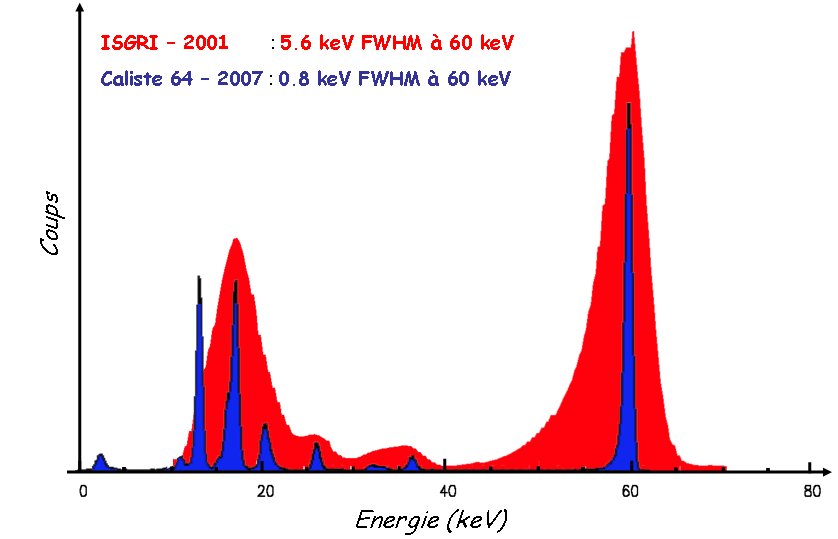A innovative hard X-ray camera X with excellent performances has been realized and tested at CEA. Result of three years of studies, this ultra-compact camera, called Caliste 64, is able to detect photons between 2 and 250 keV and therefore fills a gap between two domains, the low X-ray and the gamma ray energy bands. Its peculiar design and its integrated electronic lead to excellent performances in term of imaging and spectroscopic capabilities. This opens a new window for high energy Astrophysics. The focal plane of the futur mission Simbol-X will be equiped with this new camera while the instrument Eclairs onboard the SVOM satellite will use its readout electronic module.
A new camera for high energy Astrophysic
Exploring with a single device a spectral window going from the low X-rays (less than 10 keV) up to a few hundred of keV is a challenge that a team from CEA just realized. The first prototype of this new camera, called "Caliste 64", integrates 8x8 CdTe semiconductors along with a very powerful readout electronic. The very compact design of this elementary detection unit, no more than 10x10x18 mm3, is juxtaposable on its four sides. Consequently, large detector can be made assembling a mosaic of "Caliste" 64 units. Large field of view camera in hard X-rays like CCDs in optical is thus possible.
The spectroscopic capabilities of Caliste 64 is illustrated by this curve : in blue Caliste 64, in red the camera Isgri. A spectral resolution nearly ten times better can be achieved.

A example of a scientific application of Caliste 64. The image above (centre) is the supernova Cas A taken by the Chandra satellite. To the left the spectral distribution obtained by the ISGRI camera onboard the INTEGRAL satellite. The two red lines indicate the position of the gamma ray lines of the Titanium 44, a radioactive element synthesized during the explosion of the precursor. To the right a simulation of the spectrum of Cas A obtained with a Caliste 64 camera at the focal plane of the Simbol-X telescope. The two lines are now much better identified due to the improvement on the spectral resolution. This will allow to study in detail the expansion velocity of matter inside the remnant. Credits : image (NASA), spectrum(CEA/SAp).
For details and more informations (in french) : click HERE
Contact :
"CALISTE 64, an innovative CdTe Hard X-ray micro-camera"
A. Meuris (1), O. Limousin (1), F. Lugiez (2), O. Gevin (2), F. Pinsard (1), I. Le Mer (1), E. Delagnes(2), M.-C. Vassal(3), F. Soufflet(3), R. Bocage (3)
(1) DSM/DAPNIA/SAp, CEA Saclay, Gif-Sur-Yvette, FRANCE
(2) DSM/DAPNIA/SEDI, CEA Saclay, Gif-Sur-YVette, FRANCE
(3) 3D Plus, Buc, FRANCE
To appear in the journal IEEE TNS, April 2008
- download the pdf file - (440 Ko)
Note :
This camera is a collaboration bewtween two laboratories of the CEA-IRFU, the Service d'Astrophysique and the Service d'Electronique des Détecteurs et d'Informatique (Sédi) with the support of the french space agency, the Centre national d’études spatiales (CNES). It benefited of the expertise of 3D PLUS, a company specialized in 3-D electronics packaging.
Rédaction : Christian Gouiffès et Olivier Limousin






